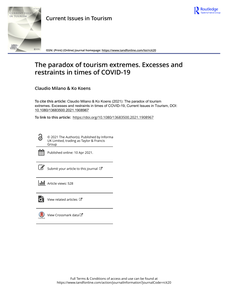Increasing youth travel has led to young people being labelled as ‘nomads’. This paper examines the phenomenon of youth nomadism in the tourism literature as well as examining recent empirical evidence. A review of the literature around youth nomadism identifies two major themes: analyses of the growth and development of youth travel niches, such as backpacking, volunteer tourism and educational exchange, and broader approaches linked to the rise of the mobilities paradigm. A major global survey of youth travel (34,000 respondents) indicates three major travel styles related to different forms of ‘nomadism’: the backpacker, the flashpacker and the global nomad. The traditional backpacker can be seen as a form of ‘neotribe’, gathering in self-sufficient enclaves. In contrast, the flashpacker, or ‘digital nomad’, utilizes existing digital and logistic infrastructure to maintain a fluid, individualized lifestyle. The global nomad, or ‘location independent traveller’, tries to integrate with the local community, while trying to avoid the strictures of ‘system’.
LINK
This paper seeks to highlight underlying issues of the tourism system that have led to tourism extremes of too much or too little tourism. Five phases are recognized that reflect different ways of dealing with too much tourism over time, after which the impact of a sudden lack of tourism is investigated in light of future renewal processes. This discussion highlights the remarkable capacity of the tourism industry to adjust to rapidly changing circumstances and crises, even when these cause anguish to individuals and within societies at large. The paper thus seeks to contextualize the current discussions regarding the transformation of tourism post COVID-19. It highlights the complexity of changing a tourism that multiple stakeholders depend on or have grown accustomed to. To come to a more balanced tourism, it is necessary to not only come up with alternative visions and strategies, but also to engage with the political economy nature of tourism development. A future research agenda should therefore also discuss facets of entangled power, social exclusion, inequalities and class differences to come to new reference points of what actually constitutes a more inclusive tourism success.
MULTIFILE
This paper seeks to highlight underlying issues of the tourism system that have led to tourism extremes of too much or too little tourism. Five phases are recognized that reflect different ways of dealing with too much tourism over time, after which the impact of a sudden lack of tourism is investigated in light of future renewal processes. This discussion highlights the remarkable capacity of the tourism industry to adjust to rapidly changing circumstances and crises, even when these cause anguish to individuals and within societies at large. The paper thus seeks to contextualize the current discussions regarding the transformation of tourism post COVID-19. It highlights the complexity of changing a tourism that multiple stakeholders depend on or have grown accustomed to. To come to a more balanced tourism, it is necessary to not only come up with alternative visions and strategies, but also to engage with the political economy nature of tourism development. A future research agenda should therefore also discuss facets of entangled power, social exclusion, inequalities and class differences to come to new reference points of what actually constitutes a more inclusive tourism success.
MULTIFILE
